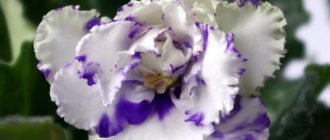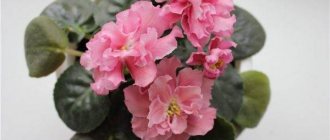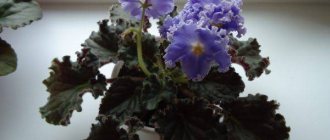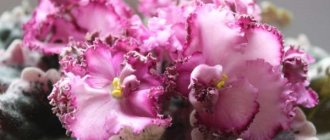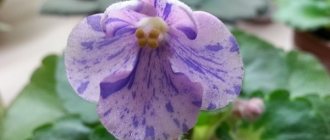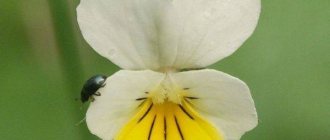In this article we will look at a photo and description of the violet variety Spanish Dancer (LLG/P.Sorano). The variety was released in 2011.
The socket is a large standard. The foliage is dark, jagged, with a red underside. Has a tendency to lift up the leaf blades.
This is especially true for young rosettes that stand on window sills. On shelves with stable lighting it forms a more even rosette .
The flower is a simple or semi-double pansy of plum color with fantasy splashes of pink. The edge of the petal is corrugated, with a thin white border along the edge.
The shape of the fantasy inclusions is polka dots, but the contours are slightly blurred. Over time, the buds begin to fade and must be removed so as not to spoil the appearance of the rosette.
But fading does not happen immediately ; as a rule, the bright and rich shade lasts for three to four weeks. Flowering is always different, with an unequal number of peas on the petals.
The peduncles are thin and tall and cannot hold buds. Therefore, all the flowers are scattered across the surface of the rosette in creative disorder.
Important! To achieve a beautiful exhibition look, it should be kept on the windowsill, and at the same time additionally illuminated. A beautiful bouquet can be obtained if you spend a fourteen-hour day on a windowsill with artificial lighting.
Large flowers are obtained only with regular fertilizing and regular replanting . With proper agricultural technology, it forms a bouquet that is larger in size than the rosette itself.
Despite the frequent and abundant flowering, not all gardeners like this variety . It is often rejected because of its long and thin peduncles and sloppy bouquet.
Sports appear as a complete absence of light fantasy inclusions. But genetic mutations are very rare. The variety is considered one of the most education-resistant sports.
Violet Lady in Red (P. Sorano/LLG)
Gorgeous violet Lady in Red.
Varieties of foreign breeders occupy a special place in the world of violets. As a rule, such plants are quite easy to maintain . Lady in Red (P.Sorano/LLG) is a fairly large standard. The leaves are dark green, with a reddish underside. Exquisite semi-double flowers in a red wine shade with a delicate pinkish border look stunning.
Brief characteristics of indoor violets
Violet (Saintpaulia) belongs to the Gesneriaceae family and grows naturally in the highlands of tropical Africa. This is a small perennial flower with a short stem, from which numerous pubescent dark green leaves emerge.
Based on the shape of the flowers, they are divided into several groups:
- simple;
- terry;
- with fringe.
And the flowers themselves are found in completely different colors: from white, cream, soft pink to bright crimson, and dark purple, blue and cherry. There are also multi-colored varieties, with a pattern or edging of a different shade.
The flowers are small in size (up to 2-4 cm), collected in inflorescences of several pieces, and hybrid varieties are several times larger than them. They have no aroma and breeders are actively working to develop varieties with a pleasant aroma.
Homemade Saintpaulia (indoor, uzambara) also has leaves of different shapes and colors. The leaves themselves are pubescent, fragile, light or dark green, round, slightly elongated or heart-shaped. Their surfaces are often decorated with spots, stripes, and rays.
Like indoor plants, this tropical guest is not very capricious, blooms for a long time, but requires compliance with certain rules of self-care.
In apartments, ampelous varieties are most often grown, which have more lush foliage, giving the flower a festive and elegant appearance.
Features of violet care
So, in the case of varietal violets, it is important to know certain care rules . Having created the necessary conditions, you can regularly admire the lush head of flowers:
- The first most important point is the composition of the soil . Saintpaulias do not tolerate heavy substrates - the root system in them will certainly rot. The best option is high-moor peat with:
- 70% perlite;
30% foam balls.
For good flowering, Saintpaulia needs to be properly cared for.
There is no need to add vermiculite - it has a moisture-retaining property, which can lead to rotting. If we are talking about wick irrigation, the ratio of peat and ripper changes to 50 to 40, respectively;
- Will pull out leaves;
And the pink border on the flowers may disappear.
The variety is suitable for shelving or for a south-east window. In this case, direct sunlight should not fall on the plant to avoid stains;
- Drooping leaves;
Or darkened cuttings.
It is especially important to monitor watering for those who have cold windows (if the flower is kept there) - a combination of drafts and overflow = rotting of the roots. Carefully seal cracks during the cold season;
Violets must be washed to remove dust.
When pests, such as ticks or scale insects, appear, it is better to use industrial preparations - they are much more effective than traditional methods.
Conditions of detention
To create optimal conditions for varietal violets in indoor culture, it is enough to maintain the classical care regimes for most Saintpaulia varieties, taking into account the nuances characteristic of slow-growing varieties:
- placement will be ideal on western or eastern window sills. The north window definitely needs lighting, the south window needs shading;
- watering should be done in measured portions and after a slight drying of the upper tier of the substrate;
- fertilizing is needed only on demand;
- illumination is shown as long-term, daylight, diffuse spectrum;
- temperature is suitable within the range of +20 + 24°C, but the violet will withstand even higher values;
- humidity can be increased by all methods except direct spraying of violets;
- The soil is required to be nutritious, well aerated, and permeable. Required with drainage;
- transplantation using gentle transshipment.
Transplantation and rejuvenation
After flowering or if the plant ages, it needs to be replanted . The container should be small; violets grow well in 100 ml plastic cups. For aesthetics, it can be placed in a beautiful flowerpot.
A typical transplant involves replacing the substrate. And if the trunk is exposed, then it needs to be cut from the bottom , like a carrot, stripping the surface to the green base. Tear off the lower leaves. After this, the plant is planted in light soil, but it is important not to bury the growing point too deep. If leaf turgor is lost, it is better to place the plant in a greenhouse.
Saintpaulia needs to be replanted once a year.
IMPORTANT! THE GREENHOUSE MUST BE VENTILATED ONCE A DAY!
If you decide to keep your violet on wick irrigation, then the composition of the soil also changes - 40 to 60 peat and cultivators . Make sure that the plant was planted on a small hill. You cannot use threads made from natural materials - they will rot.
Violet SM-Zaznoba
Bright violet Sweetheart.
A very bright seedling of Moreva, which has gained great popularity among flower growers.
The rosette is spreading, but at the same time symmetrical and looks good. Sheets :
- Large;
- Rounded;
- On long cuttings;
- Wavy along the edge;
- Dark green color.
Flowers:
- Large;
- Semi-double or single;
- With a ruffle along the edge of the petals.
The color is very delicate, pink-peach color is perfectly complemented by a white eye and a light green, pencil border.
Important! The repeatability of this variety is very high, this has been verified by flower growers and collectors.
Features of care
For good growth and development of the flower, you need to follow some additional rules :
- The lighting is bright enough, recommended under lamps to form a socket;
- The temperature depends on the expected result - for a darker color the temperature is raised, but then the eye becomes smaller and the border may disappear; as the temperature drops, the eye enlarges and the border becomes more pronounced, while the main shade remains almost unchanged;
- fertilize regularly to replenish nutrients and maintain flower size.
Reviews
Hope. “SM-Zaznoba has been in my collection for a long time. The variety is simply incomparable. The flowers are large, bright, with a wonderful combination of shades. The rosette is smooth, show-like, and perfectly formed. The main thing is that it doesn’t require much effort and grows beautifully on the windowsill.”
Olesya. “My Sweetheart was very beautiful. Large flowers, even rosette. But she disappeared in the winter. Now I’m looking for where to buy a leaf or a baby, I really like it.”
Reproduction by leaves and stepsons
How to propagate violets? There are several ways :
- Leaf;
- Or a stepson.
In the first case, you need a healthy cutting from the middle row. Never take leaves that are too small or too large! The cutting is cut at an angle of 45 degrees with a sharp blade and then placed in a plastic cup with soil.
There is another way - wait for rooting in water . As practice shows, the method with earth ends successfully in 90 percent of cases. The main thing is not to flood the soil.
After planting, the leaf is watered from a pipette and placed in a greenhouse. Enough lighting and warmth - within a couple of weeks the leaf will take root, and in a month or two it will produce babies.
The stepchildren are simply separated from the mother plant and also planted in light soil . It can take up to 10 months from planting the cutting to the first flowering. Lady in red is a rather slow developing variety.
Violet SM-Nectarine
Beautiful violet Nectarine.
One of the seedlings of Konstantin Morev. It is distinguished by especially large flowers, up to 7 cm, the shape is quite unusual, semi-double or double. Usually has a pink-coral tint , which greatly depends on the conditions of detention, and more often it blooms simply pink.
The rosette is medium in size , and the leaves are quite large on medium-length cuttings. The shade of the sheets varies depending on conditions, but is usually dark green and uniform.
There cannot be official sports, since the seedling is not recognized as a variety . But among flower growers, SM-Nectarine has long been tested and is used relatively rarely, out of 10 seedlings there are only 1-2.
Violet SM-Viva La Vita is similar in color to this variety.
Attention! Most often it produces simple flowers instead of double flowers or a different color of petals.
Features of care
The variety is not whimsical and does not require special care . It is enough to provide good lighting to obtain:
- Correct and rich color of flowers;
- And also a symmetrical, neat outlet.
Good feeding and timely watering gives a strong and well-formed bush (reacts well to wick watering).
Reproduction is carried out by all vegetative methods:
- Leaf cuttings take root well and produce several children at a time;
- Peduncles take root less well, but convey the unusual color of flowers well;
- It is rarely done, but this method brings the least number of sports.
Reviews
Inna. “My Nectarine makes me very happy. Blooms profusely and regularly. I bought it as a varietal baby, only later I found out that it was a seedling, but I don’t regret it. When propagated, the repetition is very good as for a seedling. Out of 10, only 2-3 of me do not replicate their mother’s characteristics.”
Tatiana. “I removed all Moreva seedlings from my collection. I bought them around the same time, and when they started to bloom I was disappointed. Maybe my conditions didn’t suit them, but none of them impressed me and didn’t even come close to expectations. To be sure, I let them bloom in the second round and gradually distributed everything.
SM-Nectarine is one of the disappointing ones. My flowers were small and the color was very ugly.”
Reviews
Elena - “The Lady in Red” was sent to me by a friend on the violet growers forum, in the form of a stepson. I don’t think twice and plant all the violets in purchased soil, adding a little perlite. There's just no time for dancing with a tambourine. The plant began to bloom within a couple of months, growing by leaps and bounds. The flowers are very beautiful, rich wine color"
The variety has many positive reviews.
Maria - “Personally, the variety seemed very problematic to me. Either the leaves stretch out, then the flowers are small, or the roots rot. Apparently, my conditions did not suit him. I gave it to a friend, she seems to be in bloom.”
Elizaveta - “I really liked the variety. However, I don’t have a shelving unit and all the violets grow on the window. I don’t like capricious varieties, I get rid of them quickly. “Lady in Red” has become my favorite - the flowers are simply stunning. But sometimes the flower stalks can’t stand it.”
Kira - “I received this violet as a bonus for my order. Since the colors did not inspire me at all, I simply planted the leaf in the ground, without any greenhouses. Imagine my surprise when the variety gave birth to babies before anyone else! I currently have 2 plants grown from the same leaf. One stands in the room on the dressing table as a decoration (while blooming non-stop), and the other is in the kitchen. No problems, I just fertilize it once a month and replant it in fresh soil every six months.”
Antonina - “The variety is a classic, but I didn’t like it. Very spreading rosette, few flowers. I couldn’t determine the optimal watering - I constantly dried it out, then flooded it, while trying different frequencies and amounts of water. Perhaps I just don’t have enough experience.”
Description of the variety Le - dancer
Le - a dancer was bred by breeder Elena Lebetskaya. The variety stands out for its bright pink tint of double orchid flowers with a wide, even ribbon of white fringe along the edges of each petal.
The flowers resemble stars in shape and look as if they were sculpted from wax. The average size is about 5 cm. The foliage is colored in a light green tone, has a round shape, and a standard rosette.
The variety is characterized by long flowering from the moment the first peduncle appears. The first flowering of the dancer violet is accompanied by the flowering of 9 peduncles; without much effort from the grower, the variety blooms with beautiful bright caps and does not fade for a long time.
Features of variety development
The lady in red does not tolerate :
- Sudden temperature changes;
- And drafts.
All this will negatively affect both the root system and the condition of the flowers. There are known cases when violet simply dried out all the buds under inappropriate conditions.
Lady in red very often drops flower stalks , in addition, the flowers do not last long. Collectors usually consider these factors to be disadvantages.
Another feature is a fairly spreading rosette . It is important to focus on potash fertilizers for full flowering. Large amounts of nitrogen lead to:
- Lengthening cuttings;
- And an increase in leaves.


